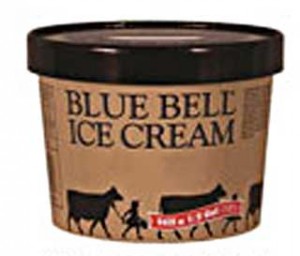The FDA has released three inspection reports of the Blue Bell ice cream facilities: one in Broken Arrow, Oklahoma, one in Brenham, Texas, and the third in Sylacauga, Alabama. We thought it would be a good idea to cover each inspection report, since they highlight problems at the company that may have led to the Listeria monocytogenes outbreak that has sickened ten people and killed three.
 The problem was first discovered at the plant in Texas. The inspections on the Brenham, Texas plant were conducted on March 16, 2015 through May 1, 2015, according to the FDA Form 483, which is published after inspections.
The problem was first discovered at the plant in Texas. The inspections on the Brenham, Texas plant were conducted on March 16, 2015 through May 1, 2015, according to the FDA Form 483, which is published after inspections.
The inspection discovered multiple problems discovered long before the recalls started . The Great Divide Bar manufactured on 1/12/15, and Chocolate Chip Country Cookie, manufactured on 1/20/15, tested positive for Listeria. The company ceased production on 1/30/15 to undergo “routine cleaning and overhauling” of a line. Listeria positive swabs were found inside the drain of the freezer tunnel, and in the outside drain of the freezer tunnel after cleaning, in 2/19/15 and 2/21/15, respectively.
After those positive tests, Blue Bell resumed operations on that line. After each day, cleaning and sanitizing was conducted. And on 3/9/15, more positive swabs were found.
The inspection report concluded that “the plant is not constructed in such a manner as to prevent condensate from contaminating food and food-contact surfaces. Inspectors observed condensate dripping directly into ice cream products on multiple occasions.”
On 3/17/15, condensate drip was falling from hoses into the stainless steel mold. After the molds were contaminated, the molds were filled with mix berry ice cream. On 3/18/15, condensate above a pint filler was dripping directly into pints of mint chocolate ice cream.
Also on 3/18/15, condensate on the filler on the 1/2 gallon line was dripping directly into 1/2 gallons of Cookies ‘n Cream. And on 4/21/15, condensate dripped on closed boxes of ice cream sandwich lids. Those lids are used to make ice cream sandwiches.
In addition, the inspection discovered employees were not cleaning food-contact surfaces “as frequently as necessary to protect against contamination of food”. Ingredient hoppers in the blending room were not kept clean. The underside of hopper lids were “caked with emulsifiers and stabilizers which had mixed with the humidity found in the room. These ingredients are added to the blender along with other ingredients.”
And there’s more. Employees did not wear beard covers when working. The buildings were not maintained “in repair sufficient to prevent food from becoming adulterated.” And paint on the ceiling directly above the blender was chipped and cracking.
This report raises questions about routine inspections conducted by government officials at that plant over the years, especially the Texas Department of State Health Services. A spokeswoman for that agency told Food Poisoning Bulletin that it does monthly inspections at Blue Bell’s Brenham facility. “We inspect these facility types monthly. Our last full inspection was February 2015. We cited a couple minor issues but nothing related to this issue,” she stated.
Why were these issues not noted and corrected earlier? Why did it take federal inspectors entering the plant to discover these violations? The Listeria monocytogenes outbreak linked to Blue Bell products goes back five years to 2010. Listeria is pervasive in the environment. Manufacturers of ready-to-eat products, such as ice cream, must be vigilant to ensure that their facilities are as clean as possible to prevent outbreaks such as this one.




